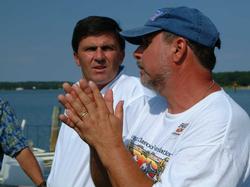 |
 |
Call Circle C @
301-872-4177
 |
 |
| Bob Ehrlich Visits Circle C Oyster Ranch August 21, 2002 |
|
by Don Statter (Circle C board of directors) photos by Richard Romer, The VOICE of Southern Maryland |
Ridge, MD - One hundred enthusiastic voters greeted Gubernatorial candidate Bob Ehrlich as he arrived at the Circle C Oyster Ranch on St. Jerome's Creek in St. Mary's County. The crowd was energized as Mr. Ehrlich explained that he was confident of victory in November as he encouraged the crowd to continue to work toward his election; and the re-election of District 29C Delegate, Anthony O'Donnell. But Bob Ehrlich was not the only point of interest at the event as many of the visitors wanted to learn more about the oysters that are grown at the largest aquaculture facility of its kind in the state of Maryland.
 Mr. Ehrlich and the crowd came down to see the future of how oyster aquaculture will be
used to clean the Bay environment, produce food, and generate new wealth for the
citizens of Maryland. The Oyster Ranch is a single long pier with approximately 100
floating oyster reefs that contain a total of 100,000 oysters. These oyster reef
systems filter and clean 5,000,000 gallons of Bay water each day. The gross value of
the oyster crop as food from this 1/10th of an acre facility is $50,000. But the real
wealth generating potential of this technology is from the Biological Nutrient Control(
(BNC) aspect the floating reef systems. A facility the size of the Oyster Ranch has the
potential to generate $167,000 in BNC system income. If you extrapolate these numbers
over a broader area you realize that oyster aquaculture has the potential to generate
over $2,000,000 per acre, per year.
Mr. Ehrlich and the crowd came down to see the future of how oyster aquaculture will be
used to clean the Bay environment, produce food, and generate new wealth for the
citizens of Maryland. The Oyster Ranch is a single long pier with approximately 100
floating oyster reefs that contain a total of 100,000 oysters. These oyster reef
systems filter and clean 5,000,000 gallons of Bay water each day. The gross value of
the oyster crop as food from this 1/10th of an acre facility is $50,000. But the real
wealth generating potential of this technology is from the Biological Nutrient Control(
(BNC) aspect the floating reef systems. A facility the size of the Oyster Ranch has the
potential to generate $167,000 in BNC system income. If you extrapolate these numbers
over a broader area you realize that oyster aquaculture has the potential to generate
over $2,000,000 per acre, per year.
 What is BNC and how does it work? Point source discharge pollution sites such as
sewage treatment plants are currently paying an average of $28/lb. for the removal of
nitrogen and phosphate nutrients. A floating oyster reef, such as a BNC system, can
profitably and effectively remove nitrogen and phosphate nutrients from the water
column for as little as $8/lb. The concept for this new approach, called nutrient
trading, is described in a US Environment Protection Agency document titled "Proposed
Water Quality Trading Policy". This EPA document encourages market based solutions
that use nutrient trading methods to reduce the cost of improving the environment.
Floating oyster reefs used as BNC systems could remove Maryland's current nutrient
load at an estimated cost of $320 million, or 28% of the $1.12 billion needed to
remove the nutrients using traditional methods. BNC trading with floating reef systems
is a new industry that will create enough wealth for over 4000 new jobs in
aquaculture, transportation, manufacturing, pollution control, research, and
education. No wonder Bob is interested in what's happening at the Circle C Oyster
Ranch.
What is BNC and how does it work? Point source discharge pollution sites such as
sewage treatment plants are currently paying an average of $28/lb. for the removal of
nitrogen and phosphate nutrients. A floating oyster reef, such as a BNC system, can
profitably and effectively remove nitrogen and phosphate nutrients from the water
column for as little as $8/lb. The concept for this new approach, called nutrient
trading, is described in a US Environment Protection Agency document titled "Proposed
Water Quality Trading Policy". This EPA document encourages market based solutions
that use nutrient trading methods to reduce the cost of improving the environment.
Floating oyster reefs used as BNC systems could remove Maryland's current nutrient
load at an estimated cost of $320 million, or 28% of the $1.12 billion needed to
remove the nutrients using traditional methods. BNC trading with floating reef systems
is a new industry that will create enough wealth for over 4000 new jobs in
aquaculture, transportation, manufacturing, pollution control, research, and
education. No wonder Bob is interested in what's happening at the Circle C Oyster
Ranch.
|
© 2011 Circle-C Oyster Ranching Association ™ 49676 Freeman's Road, Dameron, MD 20628 Local: (301) 872-5126 For Questions, Comments or Corrections, contact: WebMaster Web Page Design by: " K o o l S t u f " ~ Hosted by M i 2 |